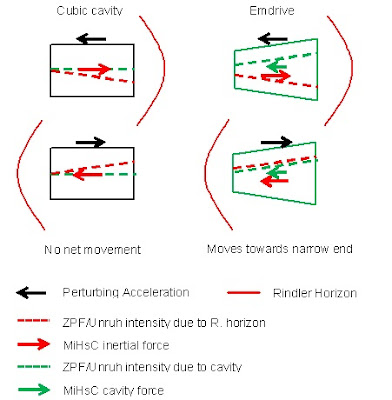In previous work I've offered an explanation for emdrive in terms of MiHsC operating on the light within the emdrive cavity (see McCulloch, 2015), and I have not abandoned this photon based approach (I'm now convinced it is better, but might benefit from the diagram below). However, in the past couple of days I've wondered whether I can do it, probably with the same maths, by looking at the cavity instead and forgetting about the light, except as a source of vibration. This schematic shows what I have been considering.
It shows, on the left, a cubic cavity (black box) accelerated left (upper panel) and right (lower panel) by the microwaves in the cavity. In each case a Rindler horizon (red curve) appears in the opposite direction to the acceleration and MiHsC then damps the Unruh radiation more on that side (see the red dashed line which shows the decrease of power in the Unruh spectrum going towards the horizon, ie: the red line trends down). This gradient in the Unruh spectrum then pushes the cubic cavity in the opposite direction to whatever acceleration it had and thereby gives it inertia (McCulloch, 2013).
Now look at the emdrive cavity (right hand side). Again we accelerate it left and right, and again the Unruh radiation spectrum decreases towards the horizon making a force that counters the initial acceleration, but now the cavity itself, assuming it's like a horizon and MiHsC applies, also damps the Unruh radiation more at the narrow end (see the green dashed line, which shows decreasing power towards the narrow end). This then, for both left and right acceleration pushes the emdrive towards its narrow end. The acceleration is essential, because without it you wouldn't have the Unruh field and the cavity wouldn't be able to make it asymmetric.
This is a different way of thinking about it than using photons, but it uses MiHsC in the same way and cuts out having to worry about light which is difficult to visualise. Comments welcome!
References
McCulloch, M.E., 2013. Inertia from an asymmetric Casimir effect. EPL, 101, 59001. Link
McCulloch, M.E., 2015. Can the Emdrive be explained by quantised inertia? Progress in Physics, 11, 1, 78-80. Link.

